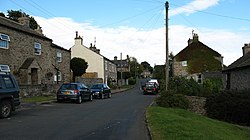Preston-under-Scar
| Preston-under-Scar | |
| Yorkshire North Riding | |
|---|---|
 Preston-under-Scar | |
| Location | |
| Grid reference: | SE070910 |
| Location: | 54°18’54"N, 1°53’33"W |
| Data | |
| Population: | 170 |
| Post town: | Leyburn |
| Postcode: | DL8 |
| Local Government | |
| Council: | North Yorkshire |
Preston-under-Scar is a village in the Wapentake of Hang West, part of historic Richmondshire in the North Riding of Yorkshire. The village is two and a half miles west of Leyburn, on the slope on the north side of Wensleydale. The population was recorded as 170 at the 2011 census.
The village is recorded in the Domesday Book of 1086, at which time it belonged to Thorfin of Ravensworth, and the tenant-in-chief was Count Alan of Bedale.[1] The name of the village derives form a mixture of Old English and Old Norse: preost tun means 'priest village (or estate)', while the Norse skeris a rock or cliff.[2]
The village was part of the parish of Wensley, so for worship the villagers walked to the church in Wensley as there was no church in the village save for a small Methodist chapel. Later a small "mission room" was built; now known as St Margaret's Church, that was built in 1862. The church is a Grade II listed building.[3]
The Wensleydale Railway passes just to the south of the village. Previously, the village and that of neighbouring Wensley were served by Wensley railway station on the line and whilst the line has been re-opened as a heritage railway, the station is in private hands and has not been opened up to passengers.
The village is just outside of the Yorkshire Dales National Park: is is excluded because of quarrying and a military firing range just to the north of the village. Besides quarrying, the area was also known for its iron ore and lead industries. These were documented as far back as the early 14th century though may have been explored earlier.
Remnants of the old lead mining industry are found in the nearby Condenser Wood. Some of the old lead processing buildings are still standing and are now listed buildings,[4] including the peat store that would house a years' worth of peat to be used in smelting lead. Several chimneys were built to vent the fumes from the smelting process, but these were quite low in the valley and would cling to the surroundings rather than disperse. Because of this, a flue was constructed that extended for a mile and a half in a northerly direction and fed into a chimney at Cobscar Mill above Preston-under-Scar[5][6]
Outside links
| ("Wikimedia Commons" has material about Preston-under-Scar) |
References
- ↑ Preston-under-Scar in the Domesday Book
- ↑ Ekwall, Eilert, The Concise Oxford Dictionary of English Place-Names. Oxford, Oxford University Press, 4th edition, 1960. p. 374 ISBN 0198691033
- ↑ National Heritage List 1130872: Church of St Margaret (Grade II listing)
- ↑ National Heritage List 1130870: Preston Mill (Grade II listing)
- ↑ Wilkinson, George (7 April 2007). "Preston-under-Scar". York Press. http://www.yorkpress.co.uk/lifestyle/countrywalks/1314866.Preston_under_Scar/?ref=arc. Retrieved 19 October 2017.
- ↑ National Heritage List 1014763: Keld Heads lead smelt mill and mine complex (Grade @ listing)